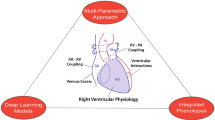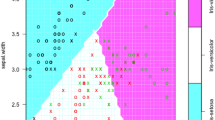Abstract
The systolic and diastolic heart failure (HF) subjects are typically categorized based on clinical indices only. The relationship between different stages of systolic and diastolic heart failure and left ventricle (LV) myocardial tissue variations is presented in this work. The corr-entropy and optimized edge criterion has been incorporated into the level set (CEOELS) for effective segmentation of myocardium in cardiovascular magnetic resonance images to handle noise, intensity inhomogeneity and contour initialization. In order to learn shape and local variations in segmented myocardium, Krawtchouk moment features are computed for ten different moment orders. The relevant extracted features are obtained through Harris hawks optimization algorithm. The optimized features are fed to support vector machine (SVM) that uses fivefold cross-validation approach for classification. Experimental results show that CEOELS has provided better segmentation of LV blood cavity and myocardium with a similarity measure of 0.93 and 0.92, respectively. It is also observed that individual Krawtchouk moment orders greater than 30 have provided better HF prediction performance. Consequently, optimized Krawtchouk moment features produced an increased overall accuracy (80.8%) than individual feature sets. Significant improvement has also been achieved in distinction of hyperdynamic patients from normal and systolic dysfunction subjects that is less explored.







Similar content being viewed by others
Availability of data and material
Not applicable.
Code availability
Not applicable.
References
Borlaug, B.A., Redfield, M.M.: Diastolic and systolic heart failure are distinct phenotypes within the heart failure spectrum. Circulation 123(18), 2006–2013 (2011)
Hunt, S.A., Abraham, W.T., Chin, M.H., Feldman, A.M., Francis, G.S., Ganiats, T.G., Jessup, M., Konstam, M.A., Mancini, D.M., Michl, K., Oates, J.A., Rahko, P.S., Silver, M.A., Stevenson, L.W., Yancy, C.W.: Focused update incorporated into the ACC/AHA 2005 guidelines for the diagnosis and management of heart failure in adults: a report of the American College of Cardiology Foundation/American Heart Association Task Force on Practice Guidelines: developed in collaboration with the International Society for Heart and Lung Transplantation. Circulation 119(14), e391–e479 (2009)
Murphy, S.P., Ibrahim, N.E., Januzzi Jr, J.L.: Heart failure with reduced ejection fraction a review. JAMA 324(5), 488–504 (2020)
Gorantla, R.S., Ahmed, S., Voruganti, D., Menzies, D.J.: Hyperdynamic left ventricle on radionuclide myocardial perfusion imaging (RNMPI): A marker of diastolic dysfunction in patients presenting with dyspnea on exertion. Int. J. Cardiol. Heart Vasc. 9, 43–47 (2015)
Ng, A.C.T., Bax, J.J.: Hyperdynamic left ventricular function and the prognostic implications for heart failure with preserved ejection fraction. Eur Heart J. 41(12), 1258–1259 (2020)
Cygan, S., Werys, K., Błaszczyk, L., Kubik, T., Kałużyński, K.: Left ventricle phantom and experimental setup for MRI and echocardiography—Preliminary results of data acquisitions. Biocybern. Biomed. Eng. 34(1), 19–24 (2014)
Duan, J., Bello, G., Schlemper, J., Bai, W., Dawes, T.J.W., Biffi, C., Marvao, A., Doumou, G., O’Regan, D.P., Rueckert, D.: Automatic 3D Bi-Ventricular segmentation of cardiac images by a shape-refined multi-task deep learning approach. IEEE Trans. Med. Imaging. 38(9), 2151–2164 (2019)
Liao, F., Chen, X., Hu, X., Song, S.: Estimation of the volume of the left ventricle from MRI images using deep neural networks. IEEE Trans. Cybern. 49(2), 495–504 (2017)
Tan, L.K., Liew, Y.M., Lim, E., McLaughlin, R.A.: Convolutional neural network regression for short-axis left ventricle segmentation in cardiac cine MR sequences. Med. Image Anal. 39, 78–86 (2017)
Tan, L.K., McLaughlin, R.A., Lim, E., Abdul Aziz, Y.F., Liew, Y.M.: Fully automated segmentation of the left ventricle in cine cardiac MRI using neural network regression. J. Magn. Reson. Imaging 48(1), 140–152 (2018)
Ngo, T.A., Lu, Z., Carneiro, G.: Combining deep learning and level set for the automated segmentation of the left ventricle of the heart from cardiac cine magnetic resonance. Med. Image. Anal. 35, 159–171 (2017)
Yang, C., Wu, W., Su, Y., Zhang, S.: Left ventricle segmentation via two-layer level sets with circular shape constraint. Magn. Reson. Imaging 38, 202–213 (2017)
Liu, Y., Captur, G., Moon, J.C., Guo, S., Yang, X., Zhang, S., Li, C.: Distance regularized two level sets for segmentation of left and right ventricles from Cine-MRI. Magn. Reson. Imaging 34(5), 699–706 (2016)
Zhou, S., Wang, J., Zhang, M., Cai, Q., Gong, Y.: Correntropy-based level set method for medical image segmentation and bias correction. Neurocomputing 234, 216–229 (2017)
Ding, K., Xiao, L., Weng, G.: Active contours driven by region-scalable fitting and optimized Laplacian of Gaussian energy for image segmentation. Signal Process. 134, 224–233 (2017)
Kotu, L.P., Engan, K., Skretting, K., Måløy, F., Orn, S., Woie, L., Eftestøl, T.: Probability mapping of scarred myocardium using texture and intensity features in CMR images. Biomed. Eng. Online. 12(91), 1–19 (2013)
Bernard, O., Lalande, A., Zotti, C., Cervenansky, F., Yang, X., Heng, P.A., Cetin, I., Lekadir, K., Camara, O., Ballester, M.A.G., Sanroma, G.: Deep learning techniques for automatic MRI cardiac multi-structures segmentation and diagnosis: is the problem solved? IEEE Trans. Med. Imaging 37(11), 2514–2525 (2018)
Isensee, F., Jaeger, P., Full, P.M., Wolf, I., Engelhardt, S., Maier-Hein, K.H.: Automatic cardiac disease assessment on cine-MRI via time-series segmentation and domain specific features. In: Pop, M., et al. (eds.) Statistical Atlases and Computational Models of the Heart, ACDC and MMWHS Challenges, pp. 120–129. Springer, Cham (2018)
Khened, M., Alex, V., Krishnamurthi, G.: Densely connected fully convolutional network for short-axis cardiac cine MR image segmentation and heart diagnosis using random forest. In: Pop, M., et al. (eds.) Statistical Atlases and Computational Models of the Heart, ACDC and MMWHS Challenges, pp. 140–151. Springer, Cham (2018)
Wolterink, J.M., Leiner, T., Veirgever, M.A., Isgum, I.: Automatic segmentation and disease classification using cardiac cine MR images. In: Pop, M., et al. (eds.) Statistical Atlases and Computational Models of the Heart, ACDC and MMWHS Challenges, pp. 101–110. Springer, Cham (2018)
Tang, L., Qian, J., Li, L., Hu, J., Wu, X.: Multimodal medical image fusion based on discrete Tchebichef moments and pulse coupled neural network. Int. J. Imaging Syst. Technol. 27(1), 57–65 (2017)
Vijayanandh, T., Shenbagavalli, A.: Tamper detection of medical images using statistical moments against various attacks. Multimed. Tools Appl. 77, 10273–10284 (2018)
Yap, P.T., Paramesran, R., Ong, S.H.: Image analysis by Krawtchouk moments. IEEE Trans. Image. Process. 12(11), 1367–1377 (2003)
Larroza, A., López-Lereu, M.P., Monmeneu, J.V., Gavara, J., Chorro, F.J., Bodí, V., Moratal, D.: Texture analysis of cardiac cine magnetic resonance imaging to detect nonviable segments in patients with chronic myocardial infarction. Med. Phys. 45(4), 1471–1480 (2018)
Mustaqeem, A., Anwar, S.M., Majid, M.: Multiclass classification of cardiac arrhythmia using improved feature selection and SVM invariants. Comput. Math. Methods. Med. 2018, 1–10 (2018)
Premkumar, J., Janney, J.B., Nanda, A., Divakaran, S., Lavanya, P.: Detection of caries in dental X ray images using Multiclass SVM. J Pharm. Sci. Res. 11(9), 3264–3268 (2019)
Zeng, N., Qiu, H., Wang, Z., Liu, W., Zhang, H., Li, Y.: A new switching-delayed-PSO-based optimized SVM algorithm for diagnosis of Alzheimer’s disease. Neurocomputing 320, 195–202 (2018)
Heidari, A.A., Mirjalili, S., Faris, H., Aljarah, I., Mafarja, M., Chen, H.: Harris hawks optimization: algorithm and applications. Future Gener. Comp. Sy. 97, 849–872 (2019)
Cappabianco, F.A.M., Ribeiro, P.F.O., Miranda, P.A.V., Udupa, J.K.: A general and balanced region-based metric for evaluating medical image segmentation algorithms. In: IEEE International Conference on Image Processing. (2019)
Heiberg, E., Sjogren, J., Ugander, M., Carlsson, M., Engblom, H., Arheden, H.: Design and validation of Segment—freely available software for cardiovascular image analysis. BMC. Med. Imaging. 10, 1–13 (2010)
Luo, G., Wang, W., Tam, C., Wang, K., Cao, S., Zhang, H., Chen, B., Li, S.: Dynamically constructed network with error correction for accurate ventricle volume estimation. Med. Image Anal. 64, 101723 (2020)
Lin, A., Wu, J., Yang, X.: A data augmentation approach to train fully convolutional networks for left ventricle segmentation. Magn. Reson. Imaging 66, 152–164 (2020)
Liu, Z., Zhang, Y., Li, W., Li, S., Zou, Z., Chen, B.: Multislice left ventricular ejection fraction prediction from cardiac MRIs without segmentation using shared SptDenNet. Comput. Med. Imaging Graph. 86, 101795 (2020)
Tripoliti, E.E., Papadopoulos, T.G., Karanasiou, G.S., Naka, K.K., Fotiadis, D.I.: Heart failure: diagnosis, severity estimation and prediction of adverse events through machine learning techniques. Comput. Struct. Biotechnol. J. 15, 26–47 (2017)
Funding
This study has no funding.
Author information
Authors and Affiliations
Corresponding author
Ethics declarations
Conflicts of interest
The authors declare that they have no conflict of interest.
Ethical approval
This article does not contain any studies with animals performed by any of the authors.
Consent to participate and for publication
This study includes the images from publicly available database (https://www.kaggle.com/c/second-annual-data-science-bowl), and the database has been cited.
Additional information
Publisher's Note
Springer Nature remains neutral with regard to jurisdictional claims in published maps and institutional affiliations.
Rights and permissions
About this article
Cite this article
Muthunayagam, M., Ganesan, K. Identification of systolic and diastolic heart failure progression with Krawtchouk moment feature-aided Harris hawks optimized support vector machine. SIViP 16, 127–135 (2022). https://doi.org/10.1007/s11760-021-01978-3
Received:
Revised:
Accepted:
Published:
Issue Date:
DOI: https://doi.org/10.1007/s11760-021-01978-3




